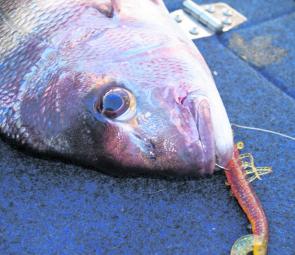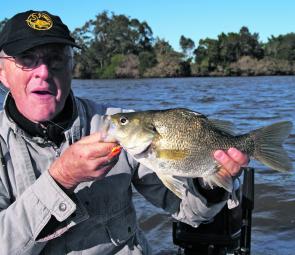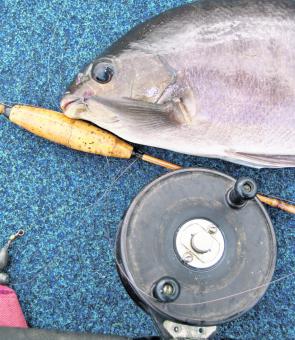Forget the golden wattle, for me the colours of Spring are pink, brown and khaki.
Those pink snapper should still be in spawning mode over the gravel and shell grit out to about 40m, the flathead are basking in the warm shallows and the ‘khaki bream’ – bass – are back in vogue after their seasonal shut-down.
It’s the bass that many fishos will be chasing as they begin their slog back to the freshwater reaches, especially the big females.
This month there could be good fish anywhere from Broadwater or Woodburn all the way up to tidal influence at Lismore or Casino.
Not all the fish spawn at once and those that did in May or early June could well be on their way home but if you find one fish, you should encounter plenty more. Just look for where food could concentrate, such as around drains, rock bars, snag piles and reedy banks, and the hungry post-spawn fish won’t be far away.
There are often staging points along the river for moving fish, too. The last deep hole before a shallow, sandy stretch is always worth exploring, as is the first one after shallows. Likewise the bends at either end of a long straight.
Although subsurface lures like spinnerbaits, blades and crankbaits are the major fish takers this month, you’d be mad not to try a surface lure of some sort early and late in the day or where you can see bait in trouble on the top.
Before it gets too hot later this month, the best bite should extend longer into the daylight hours, sometimes until mid-morning.
The tide plays a major part in bass fishing the middle reaches. The fish are often in shallower water on the first of the ebb tide and gradually move to the edges of deeper water. Migrating fish use a making tide to head upstream, feed around slack water and take shelter in eddies and around structure from the run back.
Maybe one of these years we’ll get back to those stable, dry Springs that used to be so commonplace that I always thought they were ‘normal’ weather.
A dry spell of a few weeks at this time of year does wonders for the fishing, turning the estuaries into huge waterways full of life. Water clarity improves, plant growth thrives and shrimp, prawns and baitfish prosper and multiply.
Those reaches of the Richmond from Coraki to Broadwater that have remained murky, brown and almost void of life can turn it on as oxygen levels rise and fish from the bottom end of the river head upstream to make the most of it.
Many school flathead winter over in the deeper holes in the middle reaches and while there’s been plenty of fresh water flowing down in the top layer of the river, we haven’t had anywhere near a real flood so they’ll be willing to come out and play as the water temp and oxygen levels rise.
Blades and plastics are the way to find and fool these fish. Work the shallows and drop-offs adjacent to deeper holes between Wardell and Swan Bay. If you find one fish, you’ll probably get a few so give each general area 20 or 30 exploratory casts before moving on and if you get a hit, then work the place over thoroughly.
Whiting, too, can be found in numbers over the cooler months in these middle reaches. A few years ago they hung around Woodburn in big numbers but just got poorer and skinnier as the season went on.
Many of the larger resident female flathead now start moving downstream in preparation for spawning around the river mouths later in Spring. They will be joined by those flatties that have been working along the surf line on a general northwards migration from estuary to estuary over the Winter.
On cool, bright days the fish will be up in the shallows sunbaking but the older, smarter fish are usually never far from deeper water.
It’s been the best blackfish season on the Richmond in recent memory, according to the luderick chasers. Green weed was in short supply there for a while but now appears to be more readily available from some of the local cane drains.
Spots along the inside of the ocean breakwalls have produced when the sea is rough and the Porpoise wall and the rock walls behind the Ballina CBD have proven productive.
This month the northern ferry approach and the Prospect Bridge area over North Creek will also come into their own.
The Winter beach fishing season could only be described as patchy, thanks to plenty of bouts of heavy weather that left the beaches severely eroded, in places back to 1989 levels and worse.
There should still be some bream, flathead and tailor hanging around but there will be increasing numbers of salmon as well.
These should hang around until almost Christmas, although I am yet to see the huge schools of spawning fish that were so prevalent a couple of years ago and there has only been the odd fish encountered in the Richmond around Ballina.
Out on the reefs, the snapper breeding season remains in full swing this month as these serial spawners continue their mating rituals over the beds of gravel and shell grit adjacent to the shallower reefs.
Things taper off a little towards the end of the month, with the majority of the reds moving off a little deeper, out in 40-80m. The pearl perch also head back out to their deeper haunts.
This is a popular month for teraglin off Evans Head, although there will be fewer jewfish encountered over the pinnacles and crevices.
The leatherjacket hordes have been active on the wider grounds and at times have ventured in to 40m or so, making things tiresome and expensive if you’re chasing other fish, or action-packed and fruitful if you’re just after a feed.
Reads: 1326
Snapper should still be spawning over the inshore gravel and grit patches but are still suckers for a soft plastic wafting down into the depths.

Bass in the dams get right into action this month.

Post-spawn bass, including this hatchery mutant that couldn’t resist an orange Switchblade, feed up big on prawns in the middle reaches before heading back upstream.

Blackfish are in excellent numbers in the Richmond River but are switching from a diet of sea cabbage to green and black weed.




